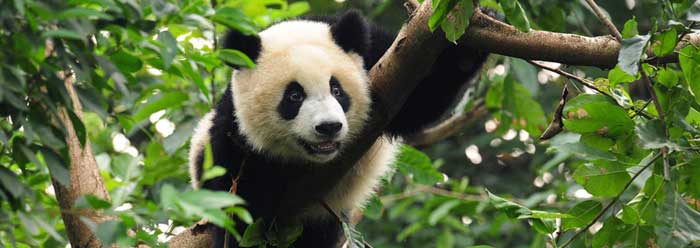Researchers from Spain's National Museum of Natural Sciences and the University of Valencia described in the journal Estudios Geologicos two fossil teeth of a panda-like bear that was smaller than today's smallest bears. It was part of a fossil assemblage of "an extraordinary concentration of micro-mammals" that were mixed with fossils of "large mammals [that] were also abundant."1 By comparing minute features of the teeth to those of similar-looking fossil teeth from France, the authors made a case for naming it as a new species.
The study authors also speculated that a formerly more tropical Spanish climate favored the small pandas during the Ice Age. Today, the area where the fossils were found has a dry climate. Perhaps the change to drier conditions lessened available habitat and food such that the ancient Spanish mini-pandas could no longer survive. And it didn't help their survival that at least some of them were swept away, buried in mud, and fossilized during an Ice Age catastrophe.2
Pandas dying from decreased habitat and from catastrophic events makes sense and is exactly what is currently happening in the dwindling Chinese panda population.3 But tropical climates do not deserve credit for favoring certain creatures.
The study authors said in a Physorg science news release, "the extinct bear would have escaped from other larger carnivores by climbing up trees."4 If so, then perhaps it would also have found its food from higher tree branches, thus filling that niche while living alongside its larger landlocked cousins.
The environment could not literally have selected the small bear size, because environments are unthinking.5 Instead, the mini-pandas most likely pioneered a formerly lush Spain, and their diminutive statures filled a specific ecological niche. If so, then the Designer of their innate abilities to generate trait variations deserves the true credit.
As had occurred with many animals as well as plants and people, extraordinary diversities rapidly rose during the Ice Age soon after the Flood. For example, some elephant and rhinoceros varieties were wooly, and others, like those surviving today, had very little body hair in comparison.6 And dire wolves were five feet long, yet were of the same dog-kind that produced Chihuahuas. Similarly, many wooly mammoths were over eight feet tall, yet fully grown dwarf mammoths were less than five feet tall.7
According to Scripture, bears once lived near the place where Noah's ark landed—near the center of the Eurasian continent. And according to science, pandas live on separate sides of that same continent. Scripture also teaches that animals were created to fill earth's environments, which God foreknew would undergo constant changes. Likewise, science confirms that creatures generate trait variations that enable them to adapt to their environments.
Last, the Scriptures teach that this world and all its animals are cursed and bound to decay. This explains the scientific notion that surviving pandas probably no longer have the robust genetic repertoire to generate giant or miniature pandas. Overall, the panda evidence fits the Bible.
References
- Abella, J. Montoya and J. Morales. 2011. A New species of Agriactos (Ailuropodinae, Ursidae, Carnivora) in the locality of Nombrevilla 2 (Aaragoza, Spain). Estudios Geologicos. 67 (2): 187-191.
- Vardiman, L. 2012. Tracking Those Incredible Hypercanes. Acts & Facts. 41 (5): 12-14.
- Thomas, B. Should We Let the Pandas Die Off? ICR News. Posted on icr.org October 5, 2009, accessed May 16, 2012.
- Giant panda's 'cousin' lived in Spain. Physorg. Posted on physorg.com May 9, 2012, accessed May 16, 2012.
- The suggestion that environments literally select commits the fallacy of reification. See: Lisle, J. Logical Fallacies: The Fallacy of Reification. Answers in Genesis. Posted on answersingenesis.org August 3, 2009, accessed May 16, 2012.
- Genesis records that Isaac, who likely lived at the end of the Ice Age, was deceived into thinking that his son Jacob was Esau when Jacob used a wool covering for his blind father to feel. Esau's body must have been very hairy, since even his hands were like sheep's wool. Genesis 27 records that Jacob placed wool on his hands and neck, and that Esau was deceived by feeling his son's wool-covered hands. Plus, these differences emerged in a single generation and in a single family, according to Genesis 27:11, which states, "And Jacob said to Rebekah his mother, Behold, Esau my brother is a hairy man, and I am a smooth man." This demonstrates the remarkable potential for extreme trait variation among early humans, paralleling the same potential among early animals.
- Perkins, S. Mini mammoth once roamed Crete. Nature. Posted on nature.com May 9, 2012, accessed May 16, 2012.
* Mr. Thomas is Science Writer at the Institute for Creation Research.
Article posted on June 15, 2012.
